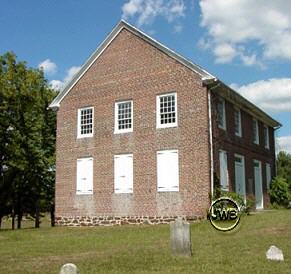
Swedesboro, N.J.
Location: Swedesboro-Sharptown Road, three miles south from the center of Swedesboro. It is now owned by the Gloucester County Historical Society and is on the National Register.
Materials of construction: a stone foundation; exterior walls are Flemish bond with red headers in front with built courses between the first and second story windows. The interior walls are wainscoting and plaster. The roof was constructed with pitch and shingles.
According to one history of Trinity Episcopal Church (in Swedesboro): "the considerable trouble from Moravian dissenters caused a division in the congregation and the establishment of the Zion Moravian Church of Oldman's Creek, south of Swedesboro, in 1743 (present building, 1786)."
The first church erected by the Moravians at Oliphant's Mill in 1747 was a log one. It was consecrated by Bishop Spangenberg and Pastor Nyberg on August 31, 1749 (old style). The ground and a large part of the lumber for this log structure was given by George Avis; this is the traditional story.The membership became so great by 1768 that the Parish appealed to the Synod at Lititz, Pennsylvania, for recognition. This they were granted and in 1769 Frederick Schmidt was appointed pastor of the 120 members of the church. His pastorate lasted until 1783. In the diary which he kept during his term he tells of hearing the cannonading of the Battle of Brandywine on September 11, 1777 and later on October 22 of Red Bank.
A skirmish occurred with the British near the Church June 12, 1778.The Reverend Francis Bohlen succeeded Pastor Schmidt in 1783. During this time we hear that the membership increased. The church was reorganized by order of Bishop Jan Von Waterville, son-in-law of Count Zinzendorf, in 1785. The present edifice was begun in the following spring. However, during the pastorate of Frederick Moehring, 1793 to 1798, the membership decreased. This was probably due to the fact that the Moravians persisted in holding the services in foreign tongues. From the time Moehring left until 1801 when Samuel Towle arrived the church was without a pastor. He left the next year and John Freytag came. He remained only a year and was the last resident pastor of the church.
In 1807, the Methodists were allowed to worship here; they were forced out, however, and built the Pilesgrove Methodist Church a short distance away. In 1834 the Episcopalians asked for the use of the building, and it was granted to them. In 1836 the church and rectory were deeded to the Protestant Episcopal Church of New Jersey. The Gloucester County Historical Society erected a tablet in 1907 bearing the following inscription:
"Near this site 1747 the Moravians erected a log church, which
was dedicated Aug. 31, 1749 O.S. by Bishop A.S. Spangenburg.
The construction of this church was begun in June 1786 and
dedicated July 5, 1789 by Bishop J. Ettwein. This property was
conveyed to the Protestant Episcopal Church of New Jersey,
October 15, 1836."This Moravian Church had the longest life of any established in
New Jersey and was the last one until the modern Moravians were established. The Moravian church was built in 1786, almost forty years after it was organized. It is a trim symmetrical brick building, with minimal decorative elements, and two front doors on the long side, in the manner of the Quaker meetinghouses.
Moravian Church in Swedesboro NJ
Photograph by J. Brown, September 2005
ALL PHOTOGRAPHS on this page are
copyrighted by J. Brown, the webmaster
Moravian Church Links:
- Swedesboro Moravian Church - Churchscapes
- Moravian Church (photographs, drawings and history ) - American Memory

Reference | Photographs | Contact | Site Map
Copyright © 2003-2020 | Janice A. Brown | All rights reserved.










